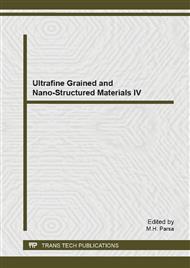[1]
A. Theriault, L. Xue, J.R. Dryden, Microstructural Evolution and Mechanical Properties of Inconel 625 Alloy during Pulsed Plasma Arc Deposition Process, Mater. Sci. Eng. A 516 (2009) 217-225.
Google Scholar
[2]
V. Shankar, K.B.S. Rao, S.L. Mannan, Mechanical Properties of Friction-Stir-Welded Inconel 625 Alloy, Nucl. Mater. 288 (2001) 222-232.
Google Scholar
[3]
L. Thivillon, Ph. Bertrand, B. Laget, I. Smurov, Laser-Assisted Fabrication of Materials, Nucl. Mater. 385 (2009) 236-241.
Google Scholar
[4]
H.Y. Zhang, S.H. Zhang, M. Cheng, Z.X. Li, MEASUREMENT AND NUMERICAL SIMULATION OF HIGH TEMPERATURE LASER MATERIAL PROCESSING, Mater. Charact. 61 (2010) 49-53.
Google Scholar
[5]
N. Kumar, S. Dash, A.K. Tyagi and Baldev Raj, 2011, Melt pool vorticity in deep penetration laser material welding, Sadhana 36(2), pp.251-265.
DOI: 10.1007/s12046-011-0017-5
Google Scholar
[6]
V. Anandkumar, E. Venkatesan, Baldev Raj, C. Karthikeyan and R.S. Babu, 1996, Laser welding of dissimular materials with large thickness ratio, Indian Welding Journal 29(2), pp.17-23.
DOI: 10.22486/iwj.v29i2.182647
Google Scholar
[7]
N.D. Evans, P.J. Maziasz, J.P. Shingledecker, Y. Yamamoto, Microstructural stability and lattice misfit characterization of nimonic 263, Mater. Sci. Eng. A 498 (2008) 412-420.
Google Scholar
[8]
R. Rodriguez, R.W. Hayes, P.B. Berbon, E.J. Lavernia, Tensile and creep behavior of cryomilled Inco 625, Acta Mater. 51 (2003) 911-929.
DOI: 10.1016/s1359-6454(02)00494-9
Google Scholar
[9]
M.D. Mathew, K.B.S. Rao, S.L. Mannan, Creep properties of service-exposed Alloy 625 after re-solution annealing treatment, Mater. Sci. Eng. A 372 (2004) 327-333.
DOI: 10.1016/j.msea.2004.01.042
Google Scholar
[10]
Arat Y , Dynamic behavior of laser welding plasma Electron and Laser Beam Technology Development and Use in Material Processing, American Society for Materials. pp. (1986)397–406.
Google Scholar
[11]
Dumord E, Jouvard J and Grevey D, Keyhole formation and power deposition in Nd: YAG laser spot welding, Laser Eng. (1999)91–21.
Google Scholar
[12]
Miyazaki T, Yoshioka S, Kimura T. Ejection of molten material produced by pulsed electron and laser beam. Prec Eng. (1988) 10: 141–6.
DOI: 10.1016/0141-6359(88)90032-3
Google Scholar
[13]
Abderrazak K, Kriaa W, BenSalem W, Mhiri H, Lepalec G, Autric M. Numerical and experimental studies of molten pool formation during an interaction of a pulse laser (Nd: YAG) with a magnesium alloy. Opt Laser Technol (2009) 41: 470–80.
DOI: 10.1016/j.optlastec.2008.07.012
Google Scholar


